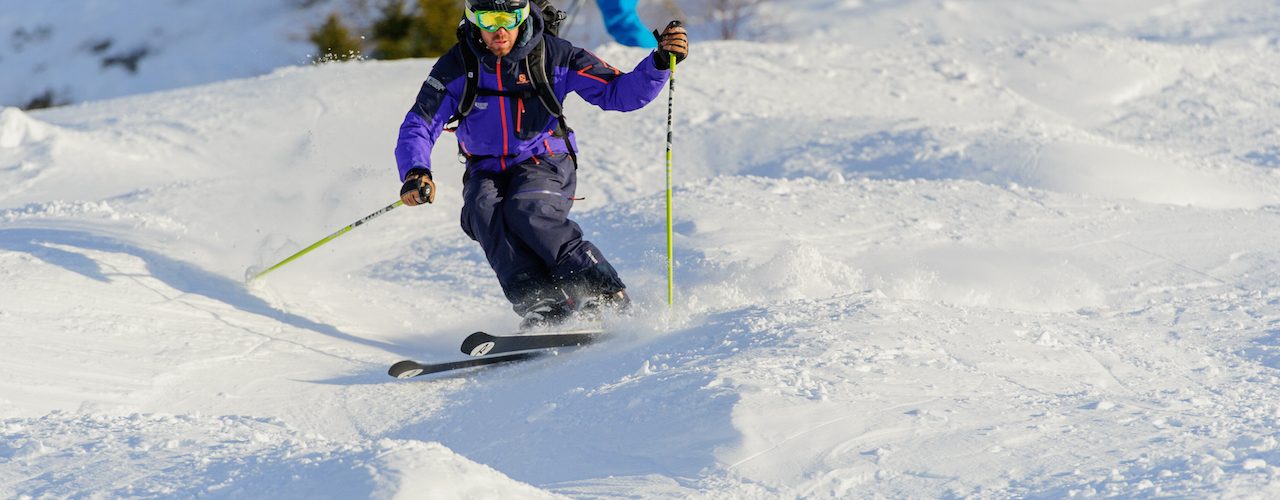Being able to ski bumps or moguls can be great fun but is also often physically demanding.
This month, Jon talks us through four key points to remember when preparing to ski snow bumps, whether it is your first time into the moguls or you are shredding the zip line!
-
Upper body vs lower body
It’s key to be able to rotate your legs while keeping the upper body quiet and still. Having good separation between the upper and lower body in the bumps will leave you like a coiled spring at the end of the turn, ready to turn the legs quickly for the next bump. This will help you get those “quick feet” that you often hear talked about in the bumps!
A quiet upper body will help with your balance, which is constantly tested in the bumps. It will also help you to look ahead and plan your route down the bumps field.
TIP: Try to look a couple of moguls ahead, and don’t look at the turn you are on or you will be too late for the next one.
-
Using your poles
Snow bumps are one of the main areas in skiing where having a solid pole plant is vital and will really pay dividends.
Every time you plant your pole you will benefit from an extra point of balance and stability, which will also encourage you to get forwards and help you maintain a rhythm.
The position of the pole plant is also key: try to pole plant over the back of the bump (make sure your poles are not too long). This will allow you to have a better flow down the field of bumps, as the upper body is less likely to be pushed back.
Tip: when planting your pole, make sure it doesn’t get left behind, otherwise that will put you in the back seat. Try to drive the hand forward as you plant it.
-
Movement and speed
Turning your leg quickly from the hip will help you to control your speed of the descent through the moguls. You will find this easier with a flat ski to start with. If using too much edge, the ski will grip and accelerate, leaving the skier in the wrong position and out of balance.
When going from the piste to the bumps, one of the biggest changes to your skiing is your range of movement in the legs. A full extension in the trough and full flexion at the top of the bump is vital to absorb the bump and maintain ski-to-snow contact for a smooth ride.
Tip: the range of movement needs to be appropriate for the size of the bumps, and you will need to have good flexibility to manage the big bumps.
-
Tall and strong
Remaining tall in the upper body will enable you to keep good balance and increase the range of movement mentioned above. Think about having a small amount of tension in your abdominal muscles. This will ensure your core stays strong and that when you hit the bump you do not collapse and break at the waist.
You can think about this position and activate your core muscles throughout your day when doing everyday tasks such as driving, working in front of your PC or vacuum cleaning.
Tip: think about carrying a tray of drinks down the bumps. If you can get to the bottom without spilling a drop, get to the bar and buy yourself one!!
Enjoy! And remember to warm up properly before every session.
For more information, please contact us on: 0041 27 771 6006; [email protected].
altitude-verbier.com – altitude-futures.com – freeride-verbier.com
About Jon “Westy” – Jon holds the top qualifications from France, Switzerland and Britain, and we can say firsthand that he is an inspirational coach. His ski school Altitude is known worldwide for employing a team of fantastic ski and snowboard instructors who are very passionate about helping people improve. Each month Jon or one of his team will provide us with a few tips and words of wisdom to help improve your understanding of how to ski.
To follow the Altitude Verbier team:
https://www.facebook.com/altitudeverbier/
https://www.instagram.com/altitudeverbier/
https://twitter.com/AltitudeVerbier

